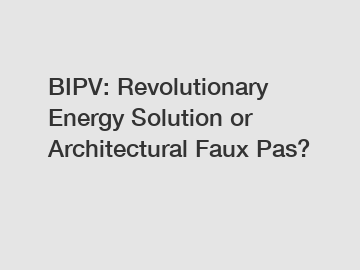Dec. 29, 2023
Energy
In the pursuit of sustainable and energy-efficient solutions, Building-Integrated Photovoltaics (BIPV) have emerged as a promising alternative to traditional energy sources. With a vision to seamlessly blend innovative architectural designs with clean energy generation, BIPV has sparked debates among experts and enthusiasts alike. In this blog, we will explore whether BIPV truly represents a revolutionary energy solution or a potential architectural faux pas.
The Dawn of BIPV:

Building-Integrated Photovoltaics incorporates solar cells directly into building materials, such as windows, roofs, facades, or even entire walls. The ingenious integration of photovoltaic elements into the building envelope allows for simultaneous power generation and architectural aesthetic appeal. Supporters of BIPV argue that these systems have the potential to generate renewable energy on a large scale, reducing dependency on fossil fuels and significantly contributing to a sustainable future.
The Power of Dual Functionality:
One of the core advantages of BIPV lies in its ability to serve multiple purposes. By converting sunlight into electricity, BIPV systems generate power while acting as functional building elements. This dual functionality eliminates the need for standalone solar panels, reducing visual clutter while creating an aesthetically pleasing and seamless integration of renewable energy solutions. The architectural versatility offered by BIPV opens up countless possibilities for designers to create visually stunning yet energy-efficient structures.
Sustainability and Energy Efficiency:
BIPV technologies have the potential to revolutionize the way we approach sustainable building design. By harnessing solar energy, buildings can minimize their carbon footprint while reducing their reliance on non-renewable energy sources. BIPV systems can effectively supplement the electrical grid, particularly during peak energy demand periods. Moreover, the integration of BIPV in building design enables a significant reduction in external energy consumption, leading to lower overall energy costs and increased energy efficiency.
Architectural Aesthetics:
Opponents of BIPV argue that the integration of solar technologies compromises the visual appeal of architectural designs. Critics argue that incorporating solar cells into building materials can result in an unsightly mismatch between the desired aesthetic and the functional power generation elements. However, advancements in BIPV technology have led to more discreet solar panels that can seamlessly blend into the overall design, alleviating this concern. Architects and designers now have an extensive range of options to choose from, ensuring synchronization between architectural vision and green energy generation.
Practical Challenges and Economic Feasibility:
Suggested reading:While BIPV holds great promise, there are practical challenges that need to be addressed. The complexity of integrating solar cells into architectural elements brings challenges regarding durability, maintenance, and installation. Ensuring the longevity and efficiency of BIPV systems remains crucial to their viability as a long-term energy solution. Additionally, the economic feasibility of implementing BIPV in large-scale projects is a significant consideration. While costs have been decreasing over time, initial investments associated with BIPV integration can still be substantial, requiring careful economic evaluation.
Government Incentives and Regulatory Framework:
To encourage the widespread adoption of BIPV, governments and regulatory bodies play a critical role in providing financial incentives and enforcing supportive policies. Tax benefits, grants, and subsidies can significantly reduce the upfront costs associated with BIPV integration. Governments should also collaborate with industry experts to establish clear guidelines and frameworks for BIPV installations, ensuring safety, quality control, and standardization across projects.
Conclusion:
Building-Integrated Photovoltaics occupies a unique space in the pursuit of renewable energy solutions and sustainable architectural designs. While challenges exist, the potential benefits offered by BIPV in terms of energy generation, architectural aesthetics, and reduced carbon footprint cannot be ignored. With further research, technological advancements, and supportive policies, BIPV has the potential to revolutionize the energy landscape, transforming buildings into clean energy generators while preserving their visual appeal.
References:
- Tang, Z., & Chen, H. (2012). Review of building integrated photovoltaic (BIPV) developments in Hong Kong and comparison with international projects. Renewable and sustainable energy reviews, 16(4), 2379-2391.
- Gürleyen, T., & Yilmaz, M. (2019). A review on building integrated photovoltaic (BIPV) systems within the sustainable architecture context.
- US Department of Energy. (2021). Building-Integrated Photovoltaics. Retrieved from https://www.energy.gov/eere/buildings/building-integrated-photovoltaics-bipv.
You can find more information on our web, so please take a look.
Are you interested in learning more about solar roof tiles sydney? Contact us today to secure an expert consultation!
Suggested reading:Previous: Revolutionize Fluid Transfers: Unveiling FDA Diaphragm Pumps for Efficient Solutions!
Next: Senergy: The Future of Renewable Energy - Explained and Debunked!
Related Articles
If you are interested in sending in a Guest Blogger Submission,welcome to write for us!
All Comments ( 0 )